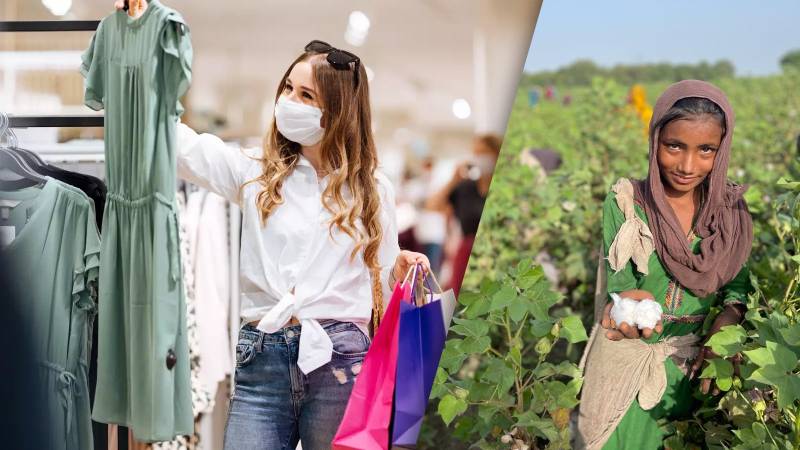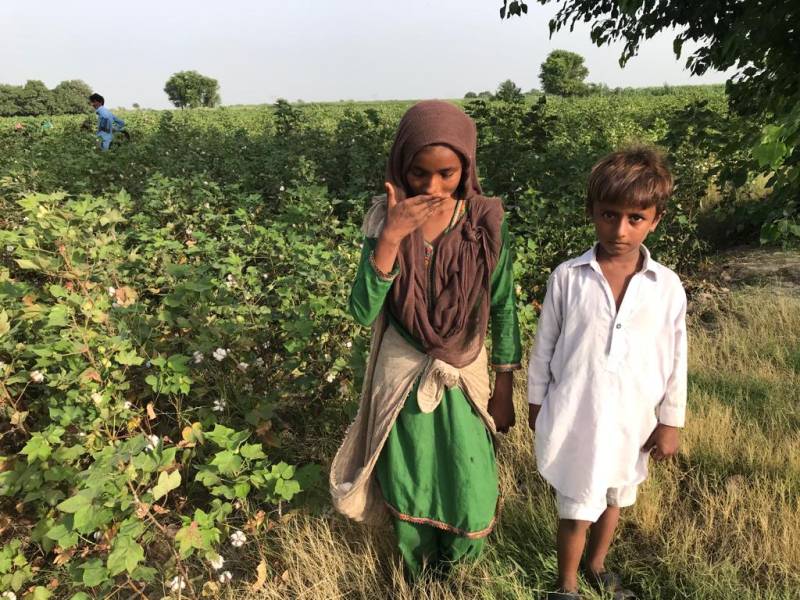
On a hot day in July, 12-year-old Iqra Solangi is picking fluffy white cotton flowers at a private farm in District Matiari, Sindh. The district is one of the most fertile regions of the province due to its close proximity to the Indus River. Iqra makes her way through the field collecting cotton with bare hands along with her mother, sister and younger cousins. She’s thin, her face sweaty, and skin dark tanned from continuous exposure to the sun.
“I get tired working from dawn to dusk,” she says. “But there’s no choice. My family needs the money.” The family is paid Rs800 ($2.8) per 40 kilogrammes (Kg) of hand-picked cotton —that’s after the wages were slightly improved last year.
Iqra says she would rather be in school, but she had to quit it after completing primary education. She is now among an estimated 22.8 million children (or about 44 percent) aged 5-16 in the country who do not go to school. The drop-out rate makes Pakistan the world’s second-largest country with out-of-school children.
Across the country, child labour remains a norm to support family income, especially in the informal agriculture economy. Women and children are poorly paid and required to work in hazardous conditions. The system is designed to keep them chained in a cycle of debt, poverty and exploitation.
This is in a country which is the sixth-biggest producer of cotton globally. Pakistan’s cotton crop was devastated in the massive floods of 2022, but the country bounced back with a bumper crop in 2023. Pakistan also has Asia’s third biggest cotton spinning capacity — after China and India — with thousands of ginning and spinning factories.
The cotton, hand-picked by children like Iqra, is sold to middlemen in local towns. From there, it is transported to ginning factories. Children are commonly employed there too. By the time the locally produced cotton ends up in urban textile mills, there is usually no way to tell which farm the cotton was sourced from to bring multi-million dollar profits to textile traders in Pakistan and Europe.
A decade of GSP+ status
The European Union gave Pakistan preferential access to its market by awarding it a Generalised System of Preferences (GSP)+ status a decade ago. In exchange, Pakistan committed itself to enforcing several reforms in key social and ecological areas. Among the 27 conventions it signed up to, they were classified under four broad themes: human rights, labour rights, environmental standards and good governance.
Both Pakistan and the EU have benefited from the GSP+ scheme over the past decade. From 2014-2022, Pakistan’s exports to the EU grew by 108%, while imports from the EU shot up by 65%. So much so, the European Union (EU) is Pakistan's second-most important trading partner, accounting for 14.3 percent of Pakistan's total trade in 2020. The GSP+ concessions allow Pakistan to export high-street clothing, bed linen, towels, hosiery and other products to the EU market, boosting the total trade volume from €8.3 billion in 2013 to €14.85 billion in 2023.
But this growth in trade appears to have had little or no effect in preventing child and forced labour. In fact, some would argue that the stakeholders have become so complacent that the situation has become worse.
Incomplete data on child labour
No one really knows about the true extent of the challenge today. The Pakistan Labour Force Survey for 2017-18 (this the most recent survey available which covers all provinces) reported 13.7 percent of children aged 10-17 years as being engaged in child labour.

Since then, Pakistan’s struggling economy has suffered multiple shocks. The COVID-19 Pandemic in 2020-21 and the devastating floods in 2022 pushed millions more into poverty. The year 2023 saw record-breaking inflation and higher-than-ever energy prices, as the country narrowly managed to avoid a fiscal default.
Amidst these crises, attempts to conduct new child labour surveys by respective provinces suffered. Some provinces dragged their feet, while others performed better. In March 2020, Punjab managed to conclude its survey in all 36 districts. By October 2021, Gilgit-Baltistan also launched its survey report. But child labour surveys in Sindh and other regions are reported to be suffering from a combination of bureaucratic delays and official apathy.
Clear Cotton project
To assist with the elimination of child labour, the EU and the International Labour Organisation (ILO) launched the Clear Cotton Project in March 2018. Besides Pakistan, it included cotton-producing countries like Burkina Faso, Mali and Peru. In Pakistan, it involved capacity building of stakeholders and awareness-raising of targeted communities. The €9 million project, spread over five years, ended in February 2023.
It’s not entirely clear what difference it made to the lives of children in forced labour or how many were put back in school, if any.
Experts say such projects usually aren’t transformative, and they have a narrow remit, but they do help in bringing about a slow, incremental change. For example, international support has helped Pakistan improve its labour laws. In Sindh, the Bonded Labour Abolition Act 2016, and the Prohibition of Employment of Children Act 2017, are cited as prime examples.
In the biggest province of Punjab, the ‘Restriction on Employment of Children Act 2016’, helped set 15 years as the minimum age for employment of adolescents and outlawed employment of 15-18 year olds in 38 hazardous occupations.
A question of will or capacity?
As is often the case with progressive legislation, implementation has been virtually non-existent.
“We now have some of the best laws but also the worst enforcement,” says Gulfam Memon, a retired official of the Sindh labour department who now works as a consultant with international organisations such as the ILO and Unicef. “In my experience, it’s evident that our governments lack the will, as well as the capacity, to try to reduce, if not eliminate, child slavery.”
In Sindh, for example, the department in charge of enforcing labour laws doesn’t have enough qualified staff. “There are only a few hundred labour inspectors for the entire province. They aren’t trained or even interested in enforcement,” says Nasir Mansoor, secretary general of the National Trade Union Federation (NTUF).
“From top to the bottom, corruption is rife. It’s open knowledge that most officials take bribes from employers and factories to look the other way.”
The Sindh labour department did not respond to requests for comment.
Traceability and transparency
The European Commission recognises that Pakistan is still far from complying with its commitments, despite some legislative reforms adopted over time. When we contacted leading high street retailers such as Zara, C&A, and H&M, they insisted in their emailed responses that they take their corporate social responsibility seriously to ensure that their suppliers in Pakistan use ethical and sustainable cotton.
None of them agreed to an interview.
Retail brands such as C&A said that they rely on third-party monitoring, assessment and certification to be reasonably sure that their imports are sustainable and in compliance with labour regulations. These are carried out by global initiatives like Better Cotton, which has been active in Pakistan since 2009.
However, no one can be really sure about the integrity of the cotton supply chain because there’s hardly been any serious attempt at setting up a farm-to-factory traceability mechanism, say campaigners.
The existing certification and due diligence practices required by leading European retail brands mostly cover the top tier of the supply chain. These include textile processing and manufacturing units in urban areas of Pakistan. It rarely ever covers farms and ginning factories where child forced labour is rampant and from where cotton is sourced.
According to Clean Clothes Campaign, a global network of over 230 trade unions and NGOs, “forced labour can be found at all levels of the garment value chains. It can be particularly prevalent at the most downstream sections of the value chain, namely the raw material harvesting (cotton picking, the spinning and weaving).”
Rights activists in Europe are pushing for greater traceability and transparency in the cotton supply chain.
New EU proposals
The European Commission is now actively considering new proposals to effectively ban products manufactured, extracted or harvested with forced labour.
A new piece of legislation could require countries to investigate alleged reports of products involving forced labour being placed in the EU market. If an investigation concludes that the product is linked to forced labour, the sale should be prohibited. Similarly, greater emphasis is being put on requiring some level of mandatory traceability.
As expected, there is a push back from European high-street retail brands. They insist that widening the supply chain due diligence is a complex phenomenon and “imposing it by law will not immediately make it happen”.
“Companies would need sufficient time to map out their complete supply chain in third countries, going all the way upstream to extraction/harvesting,” argues the European Branded Clothing Alliance (EBCA), the lobby group which includes big names like Zara, C&A and H&M.
The discussions in Brussels are a work in progress. Their outcome could have a significant impact on the use of child and bonded labour in the cotton fields and factories of Pakistan.
(This article was produced with support from Journalism Fund Europe)

